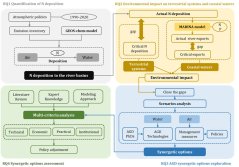
Project
Solutions for Air and WaterPollution for Agriculture Green Development in China
Better understand the impact of nitrogen deposition on water quality and explore synergetic options of air and water pollution to reduce this impact in the future.
Background
Human activities leads to excessive atmospheric nitrogen (N) deposition on land and rivers. Part of the deposited N on land is transported to rivers, contributing to water pollution by N. It is meaningful to explore synergetic measures to reduce pollution of water and atmosphere from sources simultaneously.
Objective
This project aims to better understand the impact of nitrogen deposition on water quality and explore synergetic options of air and water pollution to reduce this impact in the future.
Method
- Use Chemistry transport model - Goddard Earth Observing System with Chemistry(GEOS-chem) to quantify N deposition on land, river water and estuaries under the implementation of existing air pollution control policies.
- Improve the water quality model - Model to Assess River Inputs of PollutaNts to seA (MARINA) to quantify river export of nutrients to estuaries and analyse the environmental impacts of N deposition.
- Perform the scenario analysis to explore Agriculture Green Development (AGD) synergetic options of air and water pollution to reduce this impact in the future.

(Expected) results
Evaluate the effects of emissions controls on atmospheric nitrogen inputs to Chinese river basins
• Formulate comprehensive and synergistic options and technologies within the AGD framework to mitigate future air and water pollution in China.